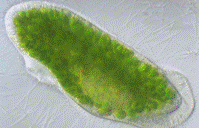Papers in the Biological Sciences
Document Type
Article
Date of this Version
2003
Citation
Applied and Environmental Microbiology, July 2003, p. 4227–4235 Vol. 69, No. 7
Abstract
The efficiency of enterobacterial disinfection is dependent largely on enterobacterial community physiology. However, the relationship between enterobacterial community physiology and wastewater processing is unclear. The purpose of this study was to investigate this relationship. The influence of wastewater treatment processes on enterobacterial community physiology was examined at the single-cell level by using cultureindependent methods. Intracellular concentrations of two conserved proteins, the growth-related protein Fis and the stationary-phase protein Dps, were analyzed by epifluoresence microscopy of uncultivated cells by using enterobacterial group-specific polyclonal fluorochrome-coupled antibodies. Enterobacterial single-cell community protein profiles were distinct for different types of biological treatment. The differences were not apparent when bulk methods of protein analysis were used. Trickling filter wastewater yielded Fis-enriched communities compared to the communities in submerged aeration basin wastewater. Community differences in Fis and Dps contents were used to predict disinfection efficiency. Disinfection of community samples by heat exposure combined with cultivation in selective media confirmed that enterobacterial communities exhibited significant differences in sensitivity to disinfection. These findings provide strategies that can be used to increase treatment plant performance, reduce the enterobacterial content in municipal wastewater, and minimize the release of disinfection by-products into receiving water.


Comments
Copyright © 2003, American Society for Microbiology. All Rights Reserved.